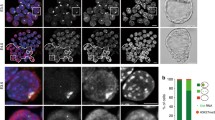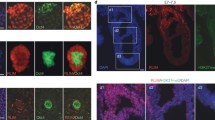Abstract
We have made a detailed study of the X-chromosome replication pattern during the period when X-inactivation is occurring in the mouse embryo. Our observations show unequivocal regionalization of the embryo with respect to the temporal appearance, parental origin and DNA replication pattern of the allocyclic X-chromosome. The switch from isocyclic to allocyclic replication occurs in the embryonic ectoderm at approximately 6 days of development and is random with respect to parental origin of the X-chromosome. In the extra-embryonic tissues, however, the switch to allocyclic replication has apparently occurred prior to 5.3 days of development and almost exclusively involves the paternally-derived X-chromosome. Since these findings are consistent with results obtained in biochemical studies of X-chromosome activity in female embryos, we conclude that there is a close temporal relationship between the cytogenetic and biochemical manifestations of the X-inactivation process. In addition, we have observed a pattern of early paternal X-chromosome replication, transitory in some cases, that is unique to extra-embryonic tissues. These results suggest that there may be some differences in the mechanism by which X-inactivation occurs in the extra-embryonic tissues as compared with the embryonic ectoderm.
Similar content being viewed by others
References
Adler, D.A., West, J.D., Chapman, V.M.: Expression of α-galactosidase in preimplantation mouse embryos. Nature 267, 838–839 (1977)
Cattanach, B.M.: A chemically-induced variegation-type position effect in the mouse. Z. Vererbungslehre 92, 165–182 (1961)
Dutrillaux, B., Fosse, A.-M.: Sur le mecanisme de la segmentation chromosomique induite par le BUDR (5-bromodeoxyuridine). Annls. Genet. 17, 207–211 (1974)
Dutrillaux, B., Laurent, C., Couturier, J., Lejeune, J.: Coloration des chromosomes humains par l'acridine orange apres traitement par le 5-bromodeoxyuridine. C.R. Acad. Sc. Paris 276, 3179–3181 (1973)
Epstein, C.J., Smith, S., Travis, B., Tucker, G.: Both X chromosomes function before visible X-chromosome inactivation in female mouse embryos. Nature 274, 500–503 (1978)
Frels, W.I., Chapman, V.M.: Expression of the maternally derived X chromosome in the mural trophoblast of the mouse. J. Embryol. exp. Morph. 56, 179–190 (1980)
Frels, W.I., Rossant, J., Chapman, V.M.: Maternal X chromosome expression in mouse chorionic ectoderm. Dev. Genet. 1, 123–132 (1979)
Gardner, R.L., Lyon, M.F.: X-chromosome inactivation studied by injection of a single cell into the mouse blastocyst. Nature 231, 385–386 (1971)
Gardner, R.L., Papaioannou, V.E.: Differentiation in the trophectoderm and inner cell mass. In: The early development of mammals (M. Balls and A.E. Wild, eds.), p. 107–132. Cambridge: Cambridge University Press 1975
Gartler, S.M., Andina, R.J.: Mammalian X-chromosome inactivation. Adv. Hum. Genet. 7, 99–140 (1977)
Kozak, L.P., Quinn, P.J.: Evidence for dosage compensation of an X-linked gene in the 6-day embryo of the mouse. Dev. Biol. 45, 65–73 (1975)
Kratzer, P.G., Gartler, S.M.: HGPRT activity changes in preimplantation mouse embryos. Nature 274, 503–504 (1978a)
Kratzer, P.G., Gartler, S.M.: Hypoxanthine guanine phosphoribosyl transferase expression in early mouse development. In: Genetic mosaics and chimeras in mammals (L.B. Russell, ed.), p. 247–260. New York: Plenum Press 1978 b
Levak-Svajger, B., Svajger, A., Skreb, N.: Separation of germ layers in presomite rat embryos. Experientia 25, 1311–1312 (1969)
Lyon, M.F.: Gene action in the X chromosome of the mouse (Mus musculus). Nature 190, 372–373 (1961)
Lyon, M.F.: X chromosome inactivation and developmental patterns in mammals. Biol. Rev. 47, 1–35 (1972)
Lyon, M.F.: Mechanisms and evolutionary origins of variable X-chromosome activity in mammals. Proc. Roy. Soc. Lond. B. 187, 243–268 (1974)
Monk, M.: Biochemical studies on mammalian X chromosome activity. In: Development in mammals 3 (M.H. Johnson, ed.), p. 189–223. Amsterdam: North-Holland 1978
Monk, M., Harper, M.I.: X-chromosome activity in preimplantation mouse embryos from XX and XO mothers. J. Embryol. exp. Morph. 46, 53–64 (1978)
Monk, M., Harper, M.I.: Sequential X chromosome inactivation coupled with cellular differentiation in early mouse embryos. Nature 281, 311–313 (1979)
Mukherjee, A.B.: Cell cycle analysis and X-chromosome inactivation in the developing mouse. Proc. Nat. Acad. Sci. 73, 1608–1611 (1976)
Papaioannou, V.E., West, J.D.: Relationship between the parental origin of the X chromosomes, embryonic cell lineage and X chromosome expression in mice. Genet. Res. 37, 183–197 (1981)
Papaioannou, V.E., West, J.D., Bücher, T., Linke, I.M.: Non-random X-chromosome expression early in mouse development. Dev. Genet. 2, 305–315 (1981)
Takagi, N.: Differentiation of X chromosomes in early female mouse embryos. Exp. Cell Res. 86, 127–135 (1974)
Takagi, N.: Preferential inactivation of the paternally derived X chromosome in mice. In: Genetic mosaics and chimeras in mammals (L.B. Russell, ed.), p. 341–359. New York: Plenum Press 1978
Takagi, N.: Primary and secondary nonrandom X chromosome inactivation in early female mouse embryos carrying Searle's translocation T(X; 16)16 H. Chromosoma 81, 439–459 (1980)
Takagi, N., Oshimura, M.: Fluorescence and Giemsa banding studies of the allocyclic X chromosome in embryonic and adult mouse cells. Exp. Cell Res. 78, 127–135 (1973)
Takagi, N., Wake, N., Sasaki, M.: Cytologic evidence for preferential inactivation of the paternally derived X chromosome in XX mouse blastocysts. Cytogenet. Cell Genet. 20, 240–248 (1978)
West, J.D., Frels, W.I., Chapman, V.M., Papaioannou, V.E.: Preferential expression of the maternally derived X chromosome in the mouse yolk sac. Cell 12, 873–882 (1977)
Wroblewska, J., Dyban, A.P.: Chromosome preparation from embryos during early organogenesis: Dissociation after fixation, followed by air drying. Stain Technol. 44, 147–150 (1969)
Author information
Authors and Affiliations
Rights and permissions
About this article
Cite this article
Takagi, N., Sugawara, O. & Sasaki, M. Regional and temporal changes in the pattern of X-chromosome replication during the early post-implantation development of the female mouse. Chromosoma 85, 275–286 (1982). https://doi.org/10.1007/BF00294971
Received:
Issue Date:
DOI: https://doi.org/10.1007/BF00294971




